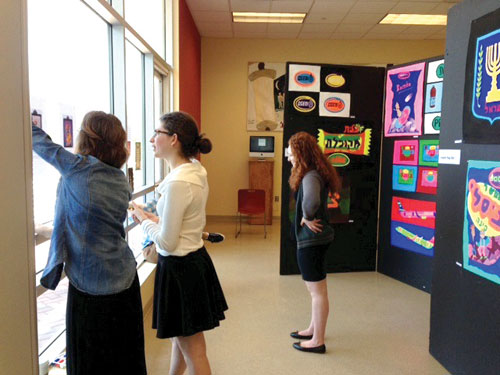.jpg) Frisch RealSchool ran its second annual Yom Iyun, Day of Learning on Sunday, April 14. RealSchool is an academic and extra-curricular program that engages students engage student-centered learning. That means that students decide what and how they learn and then collaborate on projects where they use their skills and talents to provide something of meaning and value to their community. RealSchool began as an after-school club and is divided into teams based on the students’ interests. Teams include, for example, Religious Identity, Health and Environment, Social Entrepreneurship, Video Production, Fashion, and The Arts .
Frisch RealSchool ran its second annual Yom Iyun, Day of Learning on Sunday, April 14. RealSchool is an academic and extra-curricular program that engages students engage student-centered learning. That means that students decide what and how they learn and then collaborate on projects where they use their skills and talents to provide something of meaning and value to their community. RealSchool began as an after-school club and is divided into teams based on the students’ interests. Teams include, for example, Religious Identity, Health and Environment, Social Entrepreneurship, Video Production, Fashion, and The Arts .
In the case of the Yom Iyun, two of RealSchool’s teams, Religious Identity and The Arts, got together. Eight student presenters, two sophomores, three juniors and three seniors came up with topics in Tanakh, Talmud and Jewish thought and prepared sessions on those topics. Each presenter worked with a teacher to strengthen and develop his/her points. Topics included God as Consuming Fire; Family Dynamics in Bereishit; Futility in Kohelet; Judaism and the Free Market; The Origins of Matrilineal Descent; Hagar’s Journeys; Disputes between Beit Hillel and Beit Shammai; and The Reasons for the Mitzvoth.
Yom Iyun also included an art exhibit, Texting: From Bondage to Liberation, which took participants on a visual journey from Pesach to Yom Ha’atzmaut. For the first part of the exhibit, on slavery and bondage, students in AP Art History at Frisch researched information about various famous illuminated haggadot. The art history class also repurposed a printer into the ten plagues. Using the components of the printer—which prints text—CDs, and words cut out of books and magazines, the students enabled viewers to see how the text describing God’s wonders could be reimagined in a new way.
Two seniors curated the Liberation portion of the exhibit, using the works of Kahinde Wiley, who poses Ethiopian Israelis in classical, bold ways, to show the complexities of being black in Israel and the fact that the Ethiopians, despite the challenges they encounter, enjoy being free in their homeland. Wiley’s backgrounds are inspired by illuminated manuscripts and thus connected the slavery and freedom parts of the exhibit.
Laura Friedman (’13), one of the exhibit’s curators and an artist herself, worked all year on a self-directed project researching illuminated manuscripts. For the project and exhibit, she created her own illuminated manuscript, incorporating styles from Ashkenazi and Sephardic manuscripts.
Studio Art Juniors created Pop Art versions of Israeli food packaging, and seniors brought to life images and ideas about Israeli society that inspired them. Finally, RealSchool’s Fashion Team used textiles and clothing, to create outfits that represented bondage and freedom. For example, an Israeli army uniform displayed the idea that Jews fought to live freely in Israel.
The art exhibit ended with stations where participants could make their own illuminated manuscripts using texts the presenters chose from their source sheets. This reinforced the concept of the day, which was about taking the text and reimagining it in new ways to make the tradition our own, an idea introduced at the beginning of the day by Akiva Mattenson (’13).
By Tikvah Wiener










